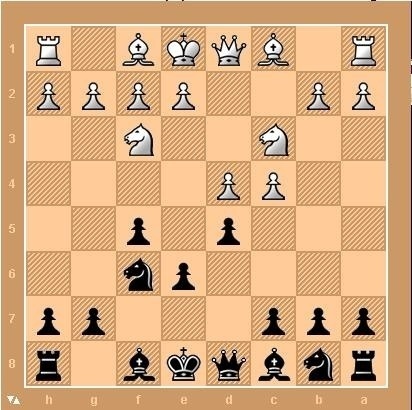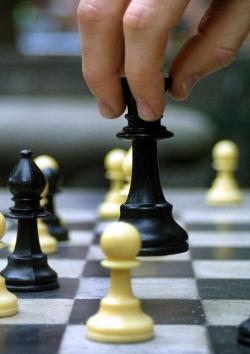This question originally appeared on Quora.
Answer by Gaurav Dutta, chess fan:
For me, the greatest sacrifice(s) would be from “The Polish Immortal Game” (Glucksberg, or Glinksberg, depending on your source, vs. Najdorf, Warsaw 1929). Now, the Polish Immortal is one of the most famous chess games of all time and there is a reason for that. It’s got a brilliant series of sacrifices that Najdorf comes up with to finish the game in only 22 moves. It would have been interesting to have been inside Najdorf’s head to see just when he realized what he had done!
Najdorf playing black opted for the Dutch Defence (f5) in response to White’s Queen’s pawn opening (d5). The game continued with the Stonewall Variation.
1. d4 f5 2. c4 Nf6 3. Nc3 e6 4. Nf3 d5

From here, the game continued with both Black and White adding to the stonewall and developing their pieces. 5. e3 c6 6. Bd3 Bd6 7. 0-0 0-0

Now this is known as the Stonewall position, but here Glucksberg decided to bring his Knight to e2, possibly to strengthen his kingside and having more options against black’s attack. Although not a common move, it definitely isn’t a blunder. After this white continued with moving his Knight down to g5 attacking Black on his kingside.
8. Ne2 Nbd7 9. Ng5


Najdorf saw this and went ahead and captured the pawn checking the King. The King moves to safety (h1) to avoid the check. Now, the knight moves to g4 to protect the bishop, and white plays the pawn to f4 to protect his knight. 9. Bxh2+! 10. Kh1 Ng4 11. f4

11. Qe8 12. g3 Qh5 13. Kg2


Variation No. 1 14. Kxg1 Qh2 #

Variation No. 2 14. Rxg1 Qh2+ Kf1 Qf2#

Najdorf comes up with another good move. He played pawn to e5. After the pawn captures (dxe5), Najdorf comes up with another sacrifice! (Ndxe5+) 14. Qh2+ 15. Kf3 e5! 16. dxe5 Ndxe5+

17. fxe5 Nxe5+

18. Kf4 Ng6+

In this position, Black came up an absolute killer move. Najdorf played Bg4+, sacrificing another bishop.
20. exf4 Bg4+

21. Kxg4 Ne5+!

White is forced to capture, as the White King has no squares left! And once the pawn takes (fxe5), Najdorf comes up with a nice little pawn move to seal Victory! 22. fxe5 h5#

1. d4 e6 2. Nf3 f5 3. Nc3 Nf6 4. Bg5 Be7 5. Bxf6 Bxf6 6. e4 fxe4 7. Nxe4 b6 8. Ne5 O-O 9. Bd3 Bb7 10. Qh5 Qe7 After the first ten moves, the position looks equal. White to move, and a mate is almost invisible to the naked eye.

The sacrifice:
But Edward Lasker sacrificed the queen here:
11. Qxh7+!!

A brilliant move. The rest of the game is a sequence of forced moves for Black side. The mate by driving the black king all the way to the other side is beautiful. 11 … Kxh7 12. Nxf6+ Kh6 13. Neg4+ Kg5 14. h4+ Kf4 15. g3+ Kf3 16. Be2+ Kg2 The mate:
And then - 17. Rh2#

Another thing, which makes this sacrifice a great one, is the king was mate on the other side of the board seven moves after the sacrifice. This is really, really difficult to calculate that many moves upfront with that many squares involved. You can view the full game here. Answer by Ram Gupta, chess player: I am a chess player, been playing this game since the age of 6. With all due respect, all of the other games already mentioned in this question are brilliant in their own regard, but none of them come even close to possessing the depth and beauty of the combination present in the game of which I am talking about. For instance, Lasker - Thomas, even though it contains a beautiful king hunt driving the king to the other side of the board, contrary to first impressions, is not very difficult to calculate for a good chess player at all since all the moves are forced. The game I am talking about was the first ever full game my first coach showed me, and I remember it to this day. It has been analysed and praised by Kasparov in the Mega Database, which is the largest database of all chess games recorded. To quote Kasparov from the same -
“I think there is reason to nominate this game the most beautiful ever played in the history of chess.”
Not many people remember Alekhine, but this game solidified him, in my opinion as one of the greatest chess players of all time. Let us not forget too that Alekhine was the only world champion in the history of chess who died holding the crown. The combination in this game is the deepest I have seen in my whole career of more than 12 years. Here, Alekhine had to calculate 16(!) moves ahead when he pushed his rook en prise on the 26th move:


Alexander Alekhine and his Two Greatest Games (chess.com) In-depth analysis (without diagrams unfortunately):
A. Alekhine; (Baden-Baden, 1925) re-play page. (lifemasteraj.com) Playthrough alternate (from http://chessgames.com ):
Richard Reti vs Alexander Alekhine (1925) “Roughin’ Reti” (chessgames.com) I apologize that I couldn’t find a better version of the game which is more user friendly. I do hope that you will take two minutes of your time to walk through this marvel of a game. I am sure you won’t be disappointed.
More questions on Chess:
